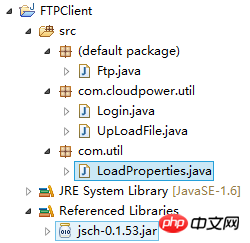本篇文章主要介绍了java实现sftp客户端上传文件以及文件夹的功能代码,具有一定的参考价值,有兴趣的可以了解一下。
1.依赖的jar文件 jsch-0.1.53.jar
2.登录方式有密码登录,和密匙登录
代码:
主函数:
import java.util.Properties;
import com.cloudpower.util.Login;
import com.util.LoadProperties;
public class Ftp {
public static void main(String[] args) {
Properties properties = LoadProperties.getProperties();
Login.login(properties);
}
}
登陆页面的代码:
package com.cloudpower.util;
import java.io.Console;
import java.util.Properties;
import com.jcraft.jsch.JSch;
import com.jcraft.jsch.Session;
public class Login {
public static void login(Properties properties) {
String ip = properties.getProperty("ip");
String user = properties.getProperty("user");
String pwd = properties.getProperty("pwd");
String port = properties.getProperty("port");
String privateKeyPath = properties.getProperty("privateKeyPath");
String passphrase = properties.getProperty("passphrase");
String sourcePath = properties.getProperty("sourcePath");
String destinationPath = properties.getProperty("destinationPath");
if (ip != null && !ip.equals("") && user != null && !user.equals("")
&& port != null && !port.equals("") && sourcePath != null
&& !sourcePath.equals("") && destinationPath != null
&& !destinationPath.equals("")) {
if (privateKeyPath != null && !privateKeyPath.equals("")) {
sshSftp2(ip, user, Integer.parseInt(port), privateKeyPath,
passphrase, sourcePath, destinationPath);
} else if (pwd != null && !pwd.equals("")) {
sshSftp(ip, user, pwd, Integer.parseInt(port), sourcePath,
destinationPath);
} else {
Console console = System.console();
System.out.print("Enter password:");
char[] readPassword = console.readPassword();
sshSftp(ip, user, new String(readPassword),
Integer.parseInt(port), sourcePath, destinationPath);
}
} else {
System.out.println("请先设置配置文件");
}
}
/**
* 密码方式登录
*
* @param ip
* @param user
* @param psw
* @param port
* @param sPath
* @param dPath
*/
public static void sshSftp(String ip, String user, String psw, int port,
String sPath, String dPath) {
System.out.println("password login");
Session session = null;
JSch jsch = new JSch();
try {
if (port <= 0) {
// 连接服务器,采用默认端口
session = jsch.getSession(user, ip);
} else {
// 采用指定的端口连接服务器
session = jsch.getSession(user, ip, port);
}
// 如果服务器连接不上,则抛出异常
if (session == null) {
throw new Exception("session is null");
}
// 设置登陆主机的密码
session.setPassword(psw);// 设置密码
// 设置第一次登陆的时候提示,可选值:(ask | yes | no)
session.setConfig("StrictHostKeyChecking", "no");
// 设置登陆超时时间
session.connect(300000);
UpLoadFile.upLoadFile(session, sPath, dPath);
} catch (Exception e) {
e.printStackTrace();
}
System.out.println("success");
}
/**
* 密匙方式登录
*
* @param ip
* @param user
* @param port
* @param privateKey
* @param passphrase
* @param sPath
* @param dPath
*/
public static void sshSftp2(String ip, String user, int port,
String privateKey, String passphrase, String sPath, String dPath) {
System.out.println("privateKey login");
Session session = null;
JSch jsch = new JSch();
try {
// 设置密钥和密码
// 支持密钥的方式登陆,只需在jsch.getSession之前设置一下密钥的相关信息就可以了
if (privateKey != null && !"".equals(privateKey)) {
if (passphrase != null && "".equals(passphrase)) {
// 设置带口令的密钥
jsch.addIdentity(privateKey, passphrase);
} else {
// 设置不带口令的密钥
jsch.addIdentity(privateKey);
}
}
if (port <= 0) {
// 连接服务器,采用默认端口
session = jsch.getSession(user, ip);
} else {
// 采用指定的端口连接服务器
session = jsch.getSession(user, ip, port);
}
// 如果服务器连接不上,则抛出异常
if (session == null) {
throw new Exception("session is null");
}
// 设置第一次登陆的时候提示,可选值:(ask | yes | no)
session.setConfig("StrictHostKeyChecking", "no");
// 设置登陆超时时间
session.connect(300000);
UpLoadFile.upLoadFile(session, sPath, dPath);
System.out.println("success");
} catch (Exception e) {
e.printStackTrace();
}
}
}
文件上传的代码:
package com.cloudpower.util;
import java.io.File;
import java.io.FileInputStream;
import java.io.IOException;
import java.io.InputStream;
import java.io.OutputStream;
import java.util.Scanner;
import com.jcraft.jsch.Channel;
import com.jcraft.jsch.ChannelSftp;
import com.jcraft.jsch.Session;
import com.jcraft.jsch.SftpException;
public class UpLoadFile {
public static void upLoadFile(Session session, String sPath, String dPath) {
Channel channel = null;
try {
channel = (Channel) session.openChannel("sftp");
channel.connect(10000000);
ChannelSftp sftp = (ChannelSftp) channel;
try {
sftp.cd(dPath);
Scanner scanner = new Scanner(System.in);
System.out.println(dPath + ":此目录已存在,文件可能会被覆盖!是否继续y/n?");
String next = scanner.next();
if (!next.toLowerCase().equals("y")) {
return;
}
} catch (SftpException e) {
sftp.mkdir(dPath);
sftp.cd(dPath);
}
File file = new File(sPath);
copyFile(sftp, file, sftp.pwd());
} catch (Exception e) {
e.printStackTrace();
} finally {
session.disconnect();
channel.disconnect();
}
}
public static void copyFile(ChannelSftp sftp, File file, String pwd) {
if (file.isDirectory()) {
File[] list = file.listFiles();
try {
try {
String fileName = file.getName();
sftp.cd(pwd);
System.out.println("正在创建目录:" + sftp.pwd() + "/" + fileName);
sftp.mkdir(fileName);
System.out.println("目录创建成功:" + sftp.pwd() + "/" + fileName);
} catch (Exception e) {
// TODO: handle exception
}
pwd = pwd + "/" + file.getName();
try {
sftp.cd(file.getName());
} catch (SftpException e) {
// TODO: handle exception
e.printStackTrace();
}
} catch (Exception e) {
// TODO Auto-generated catch block
e.printStackTrace();
}
for (int i = 0; i < list.length; i++) {
copyFile(sftp, list[i], pwd);
}
} else {
try {
sftp.cd(pwd);
} catch (SftpException e1) {
// TODO Auto-generated catch block
e1.printStackTrace();
}
System.out.println("正在复制文件:" + file.getAbsolutePath());
InputStream instream = null;
OutputStream outstream = null;
try {
outstream = sftp.put(file.getName());
instream = new FileInputStream(file);
byte b[] = new byte[1024];
int n;
try {
while ((n = instream.read(b)) != -1) {
outstream.write(b, 0, n);
}
} catch (IOException e) {
// TODO Auto-generated catch block
e.printStackTrace();
}
} catch (SftpException e) {
// TODO Auto-generated catch block
e.printStackTrace();
} catch (IOException e) {
// TODO Auto-generated catch block
e.printStackTrace();
} finally {
try {
outstream.flush();
outstream.close();
instream.close();
} catch (Exception e2) {
// TODO: handle exception
e2.printStackTrace();
}
}
}
}
}
读取配置文件的代码:
package com.util;
import java.io.File;
import java.io.FileInputStream;
import java.io.IOException;
import java.io.InputStream;
import java.util.Properties;
public class LoadProperties {
public static Properties getProperties() {
File file = new File(Class.class.getClass().getResource("/").getPath()
+ "properties.properties");
InputStream inputStream = null;
try {
inputStream = new FileInputStream(file);
} catch (IOException e) {
// TODO Auto-generated catch block
e.printStackTrace();
}
Properties properties = new Properties();
try {
properties.load(inputStream);
} catch (IOException e) {
// TODO Auto-generated catch block
e.printStackTrace();
}
return properties;
}
}
代码目录结构:

测试运行时配置文件放在项目的bin目录下(打包成可运行jar文件的时候要删除,打包完成后将配置文件和jar包放在同级目录下即可):
properties.properties
ip= user= pwd= port=22 privateKeyPath= passphrase= sourcePath= destinationPath=/home/dbbs/f
打包可运行jar文件:
Export->java->Runnabe JAR file
完成后
在控制台运行java -jar 导出jar包的名字.jar 即可
以上就是本文的全部内容,希望对大家的学习有所帮助,也希望大家多多支持PHP中文网。
更多java实现sftp客户端上传文件以及文件夹的功能相关文章请关注PHP中文网!
 是否有任何威胁或增强Java平台独立性的新兴技术?Apr 24, 2025 am 12:11 AM
是否有任何威胁或增强Java平台独立性的新兴技术?Apr 24, 2025 am 12:11 AM新兴技术对Java的平台独立性既有威胁也有增强。1)云计算和容器化技术如Docker增强了Java的平台独立性,但需要优化以适应不同云环境。2)WebAssembly通过GraalVM编译Java代码,扩展了其平台独立性,但需与其他语言竞争性能。
 JVM的实现是什么,它们都提供了相同的平台独立性?Apr 24, 2025 am 12:10 AM
JVM的实现是什么,它们都提供了相同的平台独立性?Apr 24, 2025 am 12:10 AM不同JVM实现都能提供平台独立性,但表现略有不同。1.OracleHotSpot和OpenJDKJVM在平台独立性上表现相似,但OpenJDK可能需额外配置。2.IBMJ9JVM在特定操作系统上表现优化。3.GraalVM支持多语言,需额外配置。4.AzulZingJVM需特定平台调整。
 平台独立性如何降低发展成本和时间?Apr 24, 2025 am 12:08 AM
平台独立性如何降低发展成本和时间?Apr 24, 2025 am 12:08 AM平台独立性通过在多种操作系统上运行同一套代码,降低开发成本和缩短开发时间。具体表现为:1.减少开发时间,只需维护一套代码;2.降低维护成本,统一测试流程;3.快速迭代和团队协作,简化部署过程。
 Java的平台独立性如何促进代码重用?Apr 24, 2025 am 12:05 AM
Java的平台独立性如何促进代码重用?Apr 24, 2025 am 12:05 AMJava'splatformindependencefacilitatescodereusebyallowingbytecodetorunonanyplatformwithaJVM.1)Developerscanwritecodeonceforconsistentbehavioracrossplatforms.2)Maintenanceisreducedascodedoesn'tneedrewriting.3)Librariesandframeworkscanbesharedacrossproj
 您如何在Java应用程序中对平台特定问题进行故障排除?Apr 24, 2025 am 12:04 AM
您如何在Java应用程序中对平台特定问题进行故障排除?Apr 24, 2025 am 12:04 AM要解决Java应用程序中的平台特定问题,可以采取以下步骤:1.使用Java的System类查看系统属性以了解运行环境。2.利用File类或java.nio.file包处理文件路径。3.根据操作系统条件加载本地库。4.使用VisualVM或JProfiler优化跨平台性能。5.通过Docker容器化确保测试环境与生产环境一致。6.利用GitHubActions在多个平台上进行自动化测试。这些方法有助于有效地解决Java应用程序中的平台特定问题。
 JVM中的类加载程序子系统如何促进平台独立性?Apr 23, 2025 am 12:14 AM
JVM中的类加载程序子系统如何促进平台独立性?Apr 23, 2025 am 12:14 AM类加载器通过统一的类文件格式、动态加载、双亲委派模型和平台无关的字节码,确保Java程序在不同平台上的一致性和兼容性,实现平台独立性。
 Java编译器会产生特定于平台的代码吗?解释。Apr 23, 2025 am 12:09 AM
Java编译器会产生特定于平台的代码吗?解释。Apr 23, 2025 am 12:09 AMJava编译器生成的代码是平台无关的,但最终执行的代码是平台特定的。1.Java源代码编译成平台无关的字节码。2.JVM将字节码转换为特定平台的机器码,确保跨平台运行但性能可能不同。
 JVM如何处理不同操作系统的多线程?Apr 23, 2025 am 12:07 AM
JVM如何处理不同操作系统的多线程?Apr 23, 2025 am 12:07 AM多线程在现代编程中重要,因为它能提高程序的响应性和资源利用率,并处理复杂的并发任务。JVM通过线程映射、调度机制和同步锁机制,在不同操作系统上确保多线程的一致性和高效性。


热AI工具

Undresser.AI Undress
人工智能驱动的应用程序,用于创建逼真的裸体照片

AI Clothes Remover
用于从照片中去除衣服的在线人工智能工具。

Undress AI Tool
免费脱衣服图片

Clothoff.io
AI脱衣机

Video Face Swap
使用我们完全免费的人工智能换脸工具轻松在任何视频中换脸!

热门文章

热工具

螳螂BT
Mantis是一个易于部署的基于Web的缺陷跟踪工具,用于帮助产品缺陷跟踪。它需要PHP、MySQL和一个Web服务器。请查看我们的演示和托管服务。

禅工作室 13.0.1
功能强大的PHP集成开发环境

ZendStudio 13.5.1 Mac
功能强大的PHP集成开发环境

SublimeText3汉化版
中文版,非常好用

Atom编辑器mac版下载
最流行的的开源编辑器





